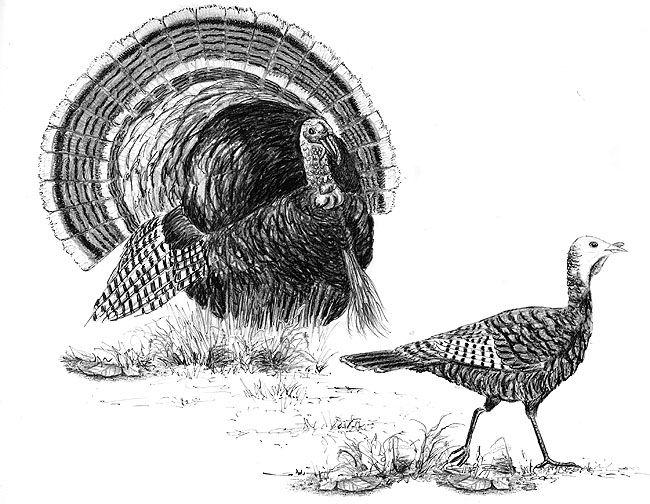
Dear Bird Folks,
Lately I have become fascinated with turkeys and have tons of questions about them. I would like to know where they nest and where they sleep. What do they eat? How many eggs do the females lay? As their population grows, are they becoming a problem? And what is that weird thing growing out of the middle of their chests?
– Ellen, Brewster, MA
Tons of problems, Ellen,
I just looked up “turkey problems” and you would not believe the trouble those birds are in. They are involved with crooked politicians, face a poor economy and have to deal with pollution and social unrest. Those crazy birds have gotten themselves into so many major difficulties it’s hard to know where to start. Wait! It seems I was reading about the problems with the country of Turkey, not the bird. Never mind.
I agree with you. I love the fact that Wild Turkeys have become a part of our landscape. I defy anyone not to smile when they see one of those feathered goofballs strutting down the road. However, there is a difference between the birds the Pilgrims encountered and the backyard birds of today. Truly wild, Wild Turkeys want nothing to do with humans. But the birds most of us see today are a new generation of friendly, urban Wild Turkeys. Why neighborhood turkeys have become so tame isn’t clear, but it could be the outcome of wild and domestic turkeys interbreeding. The result is a bird that loves the suburbs and has lost many of its wild ways. These new turkeys are sometimes tame, sometimes a problem and often funny. I like funny.
The Wild Turkey is endemic to North America. That means this is the only place on earth turkeys are naturally found. If you see Wild Turkeys in South America, Europe or Asia, they either have been introduced or are on a family holiday. Over-hunting eliminated turkeys from most of their native range, but careful management and the bird’s ability to adapt to humans have helped their population rebound. Today they are more abundant than any point in history and much of this comeback can be attributed to hard working single mom turkeys. The males have nothing to do with raising the kids. They gobble, strut, mate and that’s about it. (I have a cousin like that.)
During the winter turkeys hang out in segregated flocks. Males travel with other males and females with females. This all changes in spring when the males start looking for some action. Gobbling and tail-fanning are all the guys need to do to attract the ladies. If a female likes what she sees, the two birds will mate and that’s the end of that. The hen will go off to some quiet location to lay eggs and tend her nest, all by herself. The tom will stay behind and continue to display, hoping to score again. (Yup, just like my cousin.)
The hen’s nest is basically a simple depression on the ground, typically hidden at the base of a log and lined with dried leaves. The number of eggs laid will vary depending upon the age of the hen, but a dozen is a good average. The eggs hatch after about four weeks of incubation. Fortunately for the mother, she only has to feed her chicks for the first day or two; after that the chicks hunt for their own meals. Turkeys aren’t fussy eaters. They tend to eat mostly vegetable matter, including seeds, acorns, buds and shoots. They will also make a snack out of insects, spiders, snails and sometimes frogs and crabs, but never lobster…unless it’s on sale.
That “weird thing,” as you described it, growing out of the middle of a turkey’s chest is called a “beard.” Beards are tufts of coarse, hair-like feathers. Beards are typically only found on the males, but occasionally, just like with humans, a few females will have them, too. The length of a beard helps us judge the age of a turkey. Younger males tend to have short, 3”- 4” beards, while the older birds have much longer 10” beards, looking like the 2013 Boston Red Sox… the World Champion Boston Red Sox!
Most bird species tend to sleep in locations that are similar to where they build their nests. For example, woodpeckers sleep in tree cavities, cardinals sleep in thickets and gulls sleep on the beach. This is not the case for turkeys. They nest on the ground, but as soon as they are strong enough to fly they leave the scary ground and roost in the safety of tree branches. An entire flock will spend the night in a tree or the rooftop of a lucky homeowner, and this is where turkeys sometimes become a problem.
Complaints about turkeys include pooping on people’s lawns, decks and roofs. Turkeys also have the weird habit of blocking traffic by strolling through the middle of busy intersections (like the old squeegee men in NYC). Some turkeys, looking to dominate an area, have been known to chase people around their own yards. (See, I told you they could be funny.) Keeping birdseed off the ground is one way to discourage them from visiting your yard. A blast of water from a hose will move them off your deck or roof. Anyone approached by an aggressive turkey should stand his/her ground and move toward the bird armed with a broom or open umbrella (just makes sure someone is videoing the whole thing). As a last resort, people with serious turkey problems can release a few Mammoth Eagles to patrol their yards. Although, as I’ve recently found out, not everyone is ready for those big birds just yet.